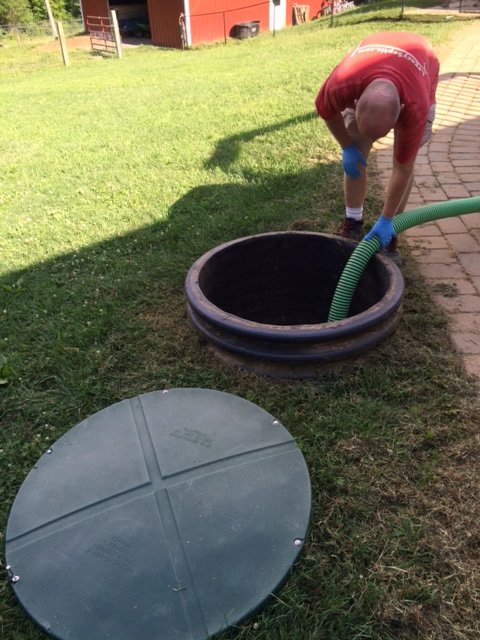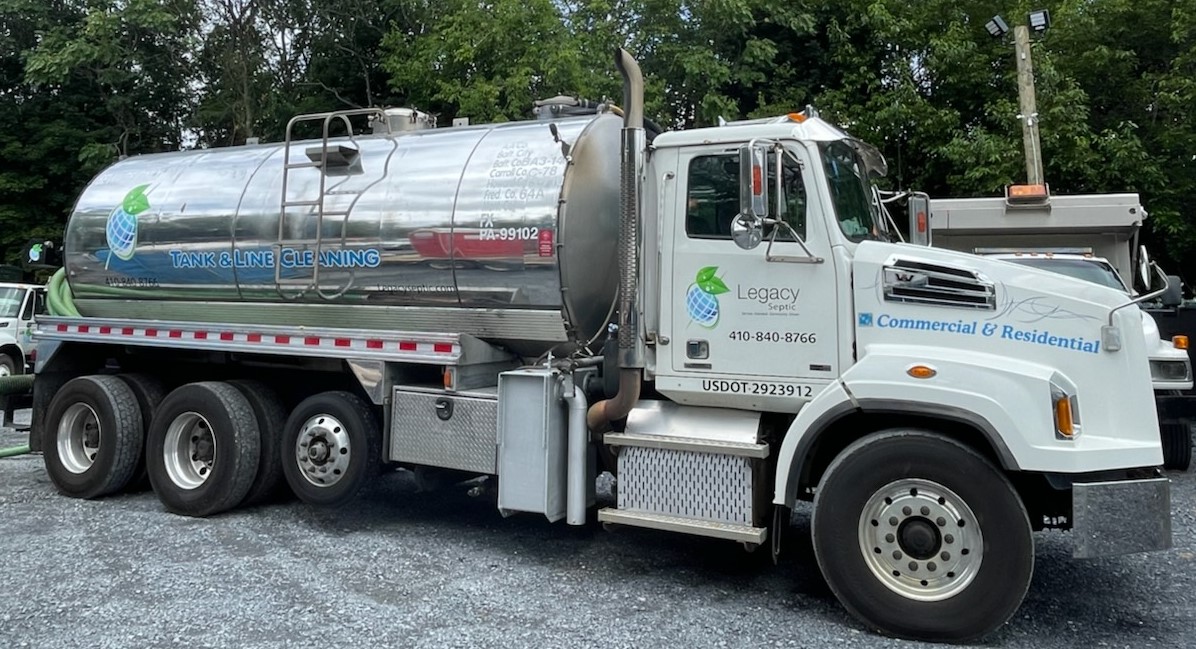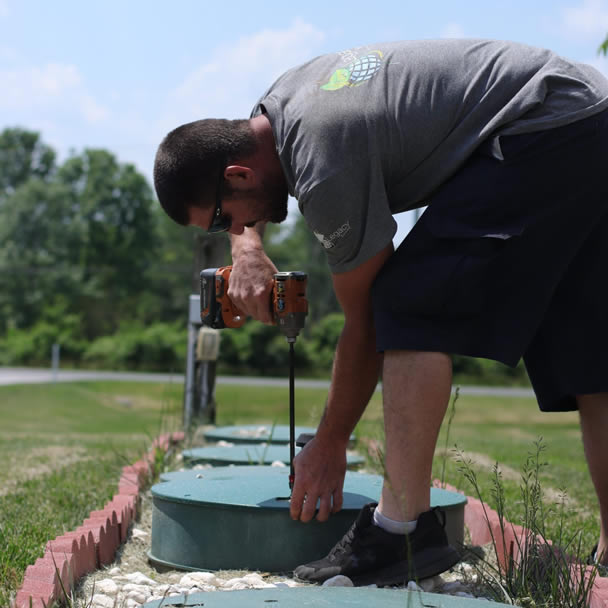Septic Pumping in Owings Mills, MD
What Residents in Owings Mills, MD, Can Look Forward to with Legacy Septic Pumping Services
With over 35 years of experience in the septic sector, Legacy Septic Services stands as the premier provider for all septic necessities in Owings Mills, MD. Our team is certified in Best Available Technology (BAT) septic systems, delivering a full spectrum of services such as installation, pumping, repairs, and clearing of septic lines.
Choosing Legacy Septic Services means we immediately coordinate with Owings Mills’ local Health Department to secure your property’s septic system records. Our goal is to gain a deep understanding of your system’s specific needs.
On the day of service, we dispatch a highly trained technician to carry out the septic tank pumping. This professional carefully identifies the tank’s location, considers any special circumstances like difficult access or pets, and calculates the required hose length. Further, through precise measurements and observations, we tailor the recommended frequency for future septic services to your needs.
After the visit, our expert reviews all collected data, addressing any required repairs, making recommendations, and noting any concerns before completing your file.
You’ll receive a packet containing a folder endorsed by the Maryland On-Site Waste Water Professionals. It includes detailed information about your septic system, such as your County Record and additional pertinent data, with a reminder of our service visit. We suggest maintaining this record for every service for your convenience.
If you’re contemplating selling your home, this detailed documentation becomes a valuable resource for your real estate agent, evidencing your diligent septic system upkeep.
Moreover, Legacy is ready to assist with any septic emergencies around the clock. Feel free to reach out to us anytime at 410-840-8766.
Why Is It Important To Get Your Septic Pumped?
Avoids System Failure: Solids accumulate at the bottom of the septic tank as sludge, and lighter materials like oils and grease rise to the surface, forming scum. Without frequent pumping, these materials can overwhelm the tank, compromising its function and possibly leading to failure. Such failures can cause sewage to back up into homes or emerge on the surface, posing significant health risks and costly repairs.
Enhances System Performance: Consistent pumping ensures the septic tank can effectively process waste, keeping solid and liquid waste separate. This separation allows for the safe release of treated water into the drainage field, crucial for preventing the contamination of groundwater and soil.
Increases System Lifespan: Although septic systems are built to last, neglect can greatly reduce their lifespan. By adhering to a regular pumping schedule, you help ensure the system’s components function correctly, extending its longevity and avoiding premature replacement costs.
Safeguards Groundwater and Soil: Properly maintained septic systems filter effluent before it enters the groundwater, preventing the overflow of solids that could block the drainage field and contaminate the environment. This is vital for protecting public health and preventing disease.
Ensures Compliance and Enhances Property Value: Adhering to local regulations requiring periodic septic inspections and pumping can avoid legal penalties. Moreover, maintaining your septic system in good condition is advantageous when selling your home, offering assurance to potential buyers of a problem-free septic system.
Pumping intervals vary depending on your tank’s size, the household size, and daily water usage, with the standard recommendation being every 3 to 5 years. Homes with higher water usage or larger families might require more frequent pumping. A consultation with a septic professional is the best way to determine a maintenance schedule tailored to your needs.
What Is The Septic Pumping Process?
Identifying the Tank’s Location: The initial step involves pinpointing the exact location of the septic tank. For some, this is known, but others may need a professional’s help. Specialists in septic services use specific tools and techniques to find tanks hidden beneath the ground, even without clear markings.
Gaining Access to the Tank:After locating the tank, accessing it is the next move. This step often involves removing the soil above the tank’s access points. Newer septic systems come with risers that reach the surface and have lids for easy access, eliminating the need for excavation. However, older systems without risers will require some digging to reveal the lid.
Tank Evaluation: Prior to the actual pumping, a preliminary inspection of the tank’s interior is conducted to evaluate the levels of liquid and solid waste. This assessment helps to understand the tank’s state and identify any immediate issues, such as leaks or structural damage.
Removing the Contents: The heart of the process is the extraction of the tank’s contents, utilizing a specialized vacuum truck fitted with a robust pump. Through an inserted hose, the truck vacuums out the tank’s contents, including the sludge (solid waste), scum (oils, grease), and liquids, transferring them to the truck’s containment area.
Tank Inspection and Cleaning: Once emptied, the technician has the opportunity to conduct a thorough inspection for any signs of wear or damage, like cracks or leaks. This phase may also include cleaning the tank’s sides to eliminate any residual waste and closely inspect the structure.
Waste Disposal: The material removed from the tank is not just thrown away. It is responsibly transported to a designated treatment facility where it’s processed in an eco-friendly manner, often being recycled into fertilizer or disposed of following specific regulations.
Securing the Tank: Following the pumping, cleaning, and any necessary inspections, the tank’s access points are securely closed. Should the ground have been disturbed for access, it’s then restored as closely as possible to its original state.
Providing Guidance and Documentation: Post-service, the technician might offer advice regarding the tank and system’s upkeep, possibly suggesting more frequent service intervals or repairs. Homeowners typically receive a detailed report summarizing the service and any notable findings.
Routine septic tank pumping is a vital maintenance activity that wards off system breakdowns, boosts the system’s longevity, and safeguards both environmental and public health. How often pumping is required can vary, influenced by the tank’s size, the household size, and water usage patterns.
How Often Should I Get My Septic Pumped?
The need for septic tank pumping depends on various factors, such as your tank’s capacity, the number of occupants in your home, and how much water you typically use. Nonetheless, specific guidelines exist to help you figure out when to schedule pumping:
Tank Capacity: A larger septic tank has the capacity to hold more solid waste before requiring pumping, in contrast to smaller tanks which reach capacity quicker.
Household Size: The presence of more individuals in a home leads to increased production of wastewater and solid waste, accelerating the rate at which the septic tank fills.
Water Usage: Higher consumption of water results in a greater flow of effluent through the septic tank, speeding up the accumulation of the solid waste layer.
Solid Waste Production: Utilizing garbage disposals, doing laundry frequently, and similar activities can raise the level of solid waste entering your septic tank, possibly necessitating sooner-than-expected pumping.
With these considerations in mind, the following guidelines can help you determine a pumping schedule:
- For 1 to 2 persons in a household: Pump every 3-4 years
- For 3 to 5 persons in a household: Pump every 2-3 years
- For 6 or more persons in a household: Pump annually or every 1-2 years
These recommendations serve as a general framework, but individual circumstances might lead to different needs. For instance, a larger family with a small tank might require more frequent pumping. Conversely, a small household with a sizable tank might not need to pump as often.
Modifying household habits to lessen the burden on your septic system is another aspect to consider. Practices like efficient water use, avoiding the disposal of non-biodegradable items down the drain, and steering clear of pouring grease or harmful chemicals into your system can diminish the frequency of required pumping.
Regular inspections by a septic professional are also beneficial. These inspections allow for an evaluation of sludge and scum levels, inspection for potential leaks or damages, and the formulation of a customized pumping timetable based on your specific situation and usage habits.
By being diligent with maintenance and conscious of your water and waste management practices, you can ensure the longevity of your septic system and avoid the need for expensive repairs or premature replacements.

Request Pumping Service
"*" indicates required fields
Call Us
Text Us
Other Septic Services
Septic Installation
Legacy Septic excels in the professional setup of septic systems, tailor-making every installation to suit your property’s unique requirements. Our team, known for their rigorous attention to detail, utilizes cutting-edge technology and adheres to the utmost safety and efficiency protocols. From the preliminary soil evaluation and system planning to the ultimate installation and final check-up, Legacy Septic ensures a smooth and hassle-free process. Our dedication to outstanding quality and client satisfaction positions us as the go-to experts for homeowners in search of dependable septic solutions. Opt for Legacy Septic for a comprehensive and customized installation service that guarantees your septic system’s durability and peak functionality.
We’re able to deliver a septic tank quicker than any competitor — your only wait is for the permits!
Septic Preventive Maintenance
Regular maintenance of your septic system is essential for prolonging its lifespan and maintaining its efficiency. Through consistent upkeep, you can prevent typical issues that may arise with septic systems, ensuring it stays in optimal condition.
Our septic preventive maintenance services include:
- Sewer Ejector Pump Preventive Maintenance Program
- Sandmound Preventive Maintenance Program
- BAT (Norweco) Septic Maintenance Program
Water/Sewer Line Repair
Even when connected to city water and sewer services, your home’s water and sewer lines can still require repairs. Vulnerable to damage from cracks, breaks, corrosion, intrusion by tree roots, freezing conditions, aging, and shifts in the ground, these lines are critical to maintain. Legacy Septic offers a full range of water and sewer line solutions, prepared to respond quickly to avert any harm to your property.
About Legacy Septic
Our mission at Legacy is to act as guides and educators within the septic field, aiding everyone from first-time homebuyers and existing homeowners to sellers on tight deadlines. We strive to equip young couples with the knowledge to identify and avoid hidden septic issues before finalizing their home purchase. For homeowners, we aim to shed light on practices that can improve the performance and extend the life of their septic systems. And for those selling their homes, especially as they approach retirement, we emphasize the importance of reassuring potential buyers about the septic system’s top-notch maintenance and status. Our approach includes engaging in community education efforts and conducting individual visits to your property, all while valuing your trust in us.




About Owings Mills, MD
Owings Mills is an unincorporated community and census-designated place in Baltimore County, Maryland. It is a suburb of Baltimore. Per the 2020 census, the population was 35,674. Owings Mills is home to approximately a dozen major shopping centers and numerous office buildings. In the center of Owings Mills was Owings Mills Mall, an enclosed shopping mall. The mall, which opened in 1986, once featured more than 150 stores. The mall closed in 2015 and was completely demolished in March 2017. The former mall has since been redeveloped into Mill Station, which is a 620,000 sq ft retail development. The first retailer to open its doors in the new Mill Station was Costco, which hosted their ribbon cutting ceremony in October 2018. It is also within walking distance of the Metro Centre, which is the northernmost stop on the Baltimore Metro.
In the early 1700s, pioneers first started settling in the area of Owings Mills. Among them was the Owings family, consisting of Welsh immigrants Samuel and Urath Owings. Samuel Owings Jr., their son, was born in 1733 in the Green Spring Valley in Baltimore County. Owings Jr. acquired Baltimore County land and, following in his father’s footsteps, got into the mill business. Owings Jr. operated three mills in Gwynn’s Falls, also in Baltimore County.
Many nationally known organizations and businesses call Owings Mills home, including CareFirst, T. Rowe Price, Lion Brothers, The Baltimore Life Companies, Talbot Settlement & Escrow, Black & Decker, the Baltimore Ravens headquarters facility, and Maryland Public Television studios (formerly the Maryland Center for Public Broadcasting).
Service Oriented. Community Driven.
Proudly serving Carroll, Baltimore, Howard and Frederick Counties, including Owings Mills, Reisterstown, Monkton, and Parkton for over 35 years!
Get Social With Us!
Contact Us!
2914 Hanover Pike
Manchester, MD 21102
Telephone: 410-840-8766
Email: info@legacyseptic.com
Text: 240-372-2744
© 2024. All Rights Reserved.




